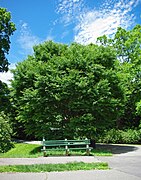| Zelkova schneideriana | |
|---|---|

| |
| Foliage | |

| |
| Detail of trunk at the Kunming Institute of Botany | |
| Scientific classification | |
| Kingdom: | Plantae |
| Clade: | Tracheophytes |
| Clade: | Angiosperms |
| Clade: | Eudicots |
| Clade: | Rosids |
| Order: | Rosales |
| Family: | Ulmaceae |
| Genus: | Zelkova |
| Species: | Z. schneideriana |
| Binomial name | |
| Zelkova schneideriana Hand.-Mazz. | |
Zelkova schneideriana, the Chinese zelkova (a name it shares with other members of its genus), is a species of flowering plant in the family Ulmaceae. It is found in southeastern Tibet, and central and southern China, usually alongside streams. A fast-growing deciduous tree with attractive exfoliating bark, it can reach 35 m (115 ft) tall and have a DBH of 80 cm (31 in). Although highly resistant to honey fungus, it can still (rarely) be afflicted with Dutch elm disease.
Uses
Its timber is high quality and resistant to decay. Fiber can be extracted from the bark and used to make paper and rope. It is used as a street tree in Wuhan, China. When planted in urban settings in North Carolina, individuals showed signs of distress including crown dieback and cracking bark.
-
 At the Arnold Arboretum
At the Arnold Arboretum
-
 Ming dynasty depiction
Ming dynasty depiction
References
- "Zelkova schneideriana Chinese zelkova". The Royal Horticultural Society. 2022. Retrieved 5 December 2022.
- "Zelkova schneideriana Hand.-Mazz". Plants of the World Online. Royal Botanic Gardens, Kew. Retrieved 5 December 2022.
- ^ "大叶榉树 da ye ju shu". Flora of China. efloras.org. 2022. Retrieved 5 December 2022.
- ^ "Zelkova schneideriana Common Name(s): Chinese Zelkova, Schneider Zelkova". North Carolina Extension Gardener Plant Toolbox. N.C. Cooperative Extension. 2022. Retrieved 5 December 2022.
- Ossola, Alessandro; Hoeppner, Malin J.; Burley, Hugh M.; Gallagher, Rachael V.; Beaumont, Linda J.; Leishman, Michelle R. (2020). "The Global Urban Tree Inventory: A database of the diverse tree flora that inhabits the world's cities". Global Ecology and Biogeography. 29 (11): 1907–1914. doi:10.1111/geb.13169. S2CID 225429443.
This Ulmaceae article is a stub. You can help Misplaced Pages by expanding it. |